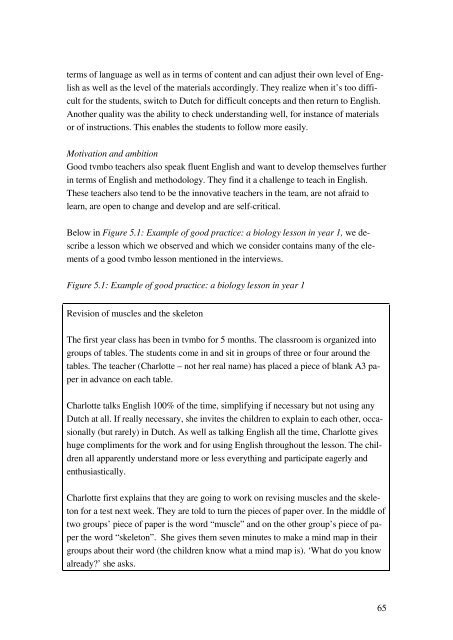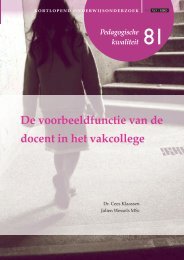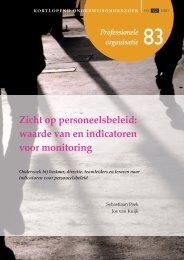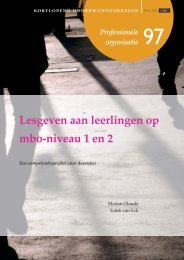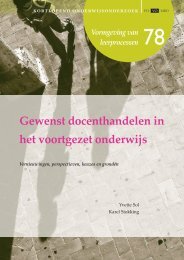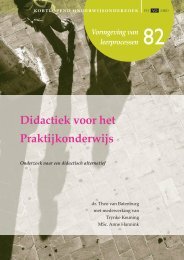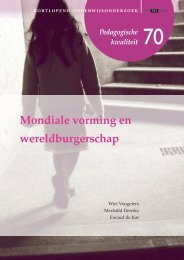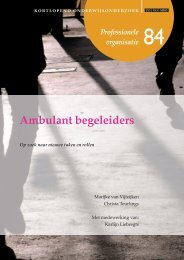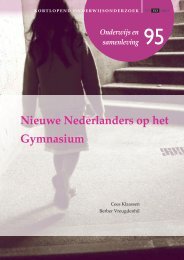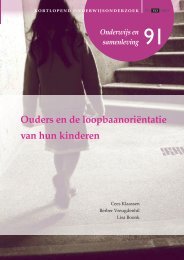Proud to be tvmbo - Kortlopend Onderwijsonderzoek
Proud to be tvmbo - Kortlopend Onderwijsonderzoek
Proud to be tvmbo - Kortlopend Onderwijsonderzoek
You also want an ePaper? Increase the reach of your titles
YUMPU automatically turns print PDFs into web optimized ePapers that Google loves.
terms of language as well as in terms of content and can adjust their own level of English<br />
as well as the level of the materials accordingly. They realize when it’s <strong>to</strong>o difficult<br />
for the students, switch <strong>to</strong> Dutch for difficult concepts and then return <strong>to</strong> English.<br />
Another quality was the ability <strong>to</strong> check understanding well, for instance of materials<br />
or of instructions. This enables the students <strong>to</strong> follow more easily.<br />
Motivation and ambition<br />
Good <strong>tvmbo</strong> teachers also speak fluent English and want <strong>to</strong> develop themselves further<br />
in terms of English and methodology. They find it a challenge <strong>to</strong> teach in English.<br />
These teachers also tend <strong>to</strong> <strong>be</strong> the innovative teachers in the team, are not afraid <strong>to</strong><br />
learn, are open <strong>to</strong> change and develop and are self-critical.<br />
Below in Figure 5.1: Example of good practice: a biology lesson in year 1, we descri<strong>be</strong><br />
a lesson which we observed and which we consider contains many of the elements<br />
of a good <strong>tvmbo</strong> lesson mentioned in the interviews.<br />
Figure 5.1: Example of good practice: a biology lesson in year 1<br />
Revision of muscles and the skele<strong>to</strong>n<br />
The first year class has <strong>be</strong>en in <strong>tvmbo</strong> for 5 months. The classroom is organized in<strong>to</strong><br />
groups of tables. The students come in and sit in groups of three or four around the<br />
tables. The teacher (Charlotte – not her real name) has placed a piece of blank A3 paper<br />
in advance on each table.<br />
Charlotte talks English 100% of the time, simplifying if necessary but not using any<br />
Dutch at all. If really necessary, she invites the children <strong>to</strong> explain <strong>to</strong> each other, occasionally<br />
(but rarely) in Dutch. As well as talking English all the time, Charlotte gives<br />
huge compliments for the work and for using English throughout the lesson. The children<br />
all apparently understand more or less everything and participate eagerly and<br />
enthusiastically.<br />
Charlotte first explains that they are going <strong>to</strong> work on revising muscles and the skele<strong>to</strong>n<br />
for a test next week. They are <strong>to</strong>ld <strong>to</strong> turn the pieces of paper over. In the middle of<br />
two groups’ piece of paper is the word “muscle” and on the other group’s piece of paper<br />
the word “skele<strong>to</strong>n”. She gives them seven minutes <strong>to</strong> make a mind map in their<br />
groups about their word (the children know what a mind map is). ‘What do you know<br />
already?’ she asks.<br />
65


